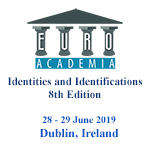Euroacademia Conferences
 Europe Inside-Out: Europe and Europeanness Exposed to Plural Observers (9th Edition) April 24 - 25, 2020
Europe Inside-Out: Europe and Europeanness Exposed to Plural Observers (9th Edition) April 24 - 25, 2020 Identities and Identifications: Politicized Uses of Collective Identities (9th Edition) June 12 - 13, 2020
Identities and Identifications: Politicized Uses of Collective Identities (9th Edition) June 12 - 13, 2020 8th Forum of Critical Studies: Asking Big Questions Again January 24 - 25, 2020
8th Forum of Critical Studies: Asking Big Questions Again January 24 - 25, 2020 Re-Inventing Eastern Europe (7th Edition) December 13 - 14, 2019
Re-Inventing Eastern Europe (7th Edition) December 13 - 14, 2019 The European Union and the Politicization of Europe (8th Edition) October 25 - 26, 2019
The European Union and the Politicization of Europe (8th Edition) October 25 - 26, 2019 Identities and Identifications: Politicized Uses of Collective Identities (8th Edition) June 28 - 29, 2019
Identities and Identifications: Politicized Uses of Collective Identities (8th Edition) June 28 - 29, 2019 The European Union and the Politicization of Europe (7th Edition) January 25 - 26, 2019
The European Union and the Politicization of Europe (7th Edition) January 25 - 26, 2019 7th Forum of Critical Studies: Asking Big Questions Again November 23 - 24, 2018
7th Forum of Critical Studies: Asking Big Questions Again November 23 - 24, 2018 Europe Inside-Out: Europe and Europeanness Exposed to Plural Observers (8th Edition) September 28 - 30, 2018
Europe Inside-Out: Europe and Europeanness Exposed to Plural Observers (8th Edition) September 28 - 30, 2018 Identities and Identifications: Politicized Uses of Collective Identities (7th Edition) June 14 - 15, 2018
Identities and Identifications: Politicized Uses of Collective Identities (7th Edition) June 14 - 15, 2018
Papers
The Fight to End Violence Against Women and the Construction of a Feminist Europe
I explore how emotional processes – namely, the practices of feminist anger – have forged a "feminist Europe" identity which states are pressured to adopt or run the risk of exclusion. Constructing an epistemic worth of subjects, forming the economies in which they operate, shaping collective subjectivities, and framing public policy, I will show that VAW campaigns have helped legitimize and institutionalize gender-specific lived experiences of emotion (such as feminist anger) within European governance structures, even generating a professional gender-specific expertise for identifying diverse and multidimensional forms of suffering and injustice.Image, Identity and Activism: A Study of the Campaign to Repeal the 8th Amendment to the Constitution in Order to Secure Abortion Rights for Women in Ireland
This paper provides a semiotic analysis of a range of images used in the campaign. The paper considers the meaning of the images, in the campaign and in Irish society and culture. The paper considers the politicisation of the images used. The analysis examines the effectiveness both of the images used in the campaign and the effective use of images in the campaign. The paper sheds light on the use of the visual in the development of a cohesive collective identity for the campaign. Finally, the paper considers the utility of the campaign and the lessons learned in the campaign while proposing the campaign as a model or case study for similar campaigns globally.Me & Mine: Personal Identity and Property: A Tangled Web
First, one of the reasons why we care about personal identity is because it settles property issues. But at the same time, what makes me the same person as the one who painted it is that the memory of painting it is rightfully mine. Thus sameness of self settles property but sameness of self presupposes a notion of property (whereby my body and my memories belong to me). Is this a vicious circle? Furthermore, the fission issue also raises thorny property issues: if both B and C equally lay claim to being A, then how do they settle which of them gets which of his items of property? I will argue that personal identity may actually be more of a legal/normative concept and less a subject to be settled by the metaphysicians than debate since Locke has suggested.How to Resist Demonization of Identities? A Philosophical Reading of the Recognition of the Indian Muslim Identity
I argue that in the context of Indian Muslims, what is to be recognized is not merely the exotic Taylorian difference of an identity but the dynamic differencing historical human process that makes the disparate identity-continuum the way it is. The ontological force of the argument aside, I will establish that homogenizing and essentializing the differences within an identity-constellation is a strategy of oppressors to make of a people a ‘demonized other’, thus forcing the victim to internalize and live by that monstrous self-image. Identities are not prison houses of the self, but liquid continuums within which happens self-making, and which, in turn, are shaped by the self’s everyday doings.Empire as ‘Una Persona’: Politicizing the Unity of the Person in Seneca’s De Clementia
Seneca argues that the unity of the state relies on the unity of the prince, while the unity of the prince means that the prince has a coherent and unified psychological state. The conflicted internal identities of a single person will result in the separation of the whole state. De Clementia is one of the earliest attempts in the European intellectual history to politicize the personal identity for the sake of the unity of the whole Europe. By examining how Seneca intertwines the two senses of identity in the body metaphor in De Clementia, this paper aims to provide the modern readers a historical perspective to understand the relationship between personal identity and political unity.‘A Torn Country’: Deconstructing the Debates Surrounding the Turkish Accession to European Union through the Prism of the Myth of ‘The Clash Of Civilizations’ (2002-2005)
Within a geopolitical context marked by an increased instrumentalization of religious and ethnical factors in the understanding of world affairs, my goal is to understand how press articles construct the current events of EU when it is confronted with a country which profoundly challenges its identity. In that respect, the main paradigms referred to by two internationally diffused European newspapers: Le Monde and The Guardian will be deconstructed. Based on the theory developed by Chiara Bottici and Benoît Challand in their book, The Myth of the Clash of Civilizations (2010), my hypothesis is that this event of the European integration is constructed by the press, in symbiosis with the European Union’s representatives, as a readapted variant of the political myth constituted by the thesis of Samuel P. Huntington.National vs European Identity in the Preparation for the European Parliamentary Elections
The European identity presuppose loyalty to the European institutions that express the interest of the Union. Member States – especially the recently joined – still insist on strengthening their national identities in the hope of get more political credits at home. Widening the Union’s competence is considered a direct danger to the power of the populist national governments in some countries in Eastern Europe. Instead of perceiving the supranational nature of the Union as a facilitation, these governments use “Europe” a major threat for their power. This study argues that the policy of the populist government in Hungary represents a battle between national and European identity.The EU and Its Sub-Self Others: The Struggle Against Disintegration in the Context of the ‘Migration Crisis’
The application of Foucauldian discourse analysis to the institutions´ migration discourse(s) since 2011 renders visible the EU´s triangle of modern subject formation practices vis-à-vis ´the migrants` and the Member States. It provides evidence against the assumption of a permanently resolved, unproblematically hierarchized and uncontested layering of already fully constituted, separate and distinct identities of the EU and the Member States and thus against the underlying premature categorization of the EU as post-modern/post-Westphalian. In terms of EU integration theory, the findings furthermore point to a renewed relevance of the classical Mitrany problem.Yugoslavia on Instagram: The (Re)Construction of a Collective Identity from the Past
Social media represent a space that allows users to collect memories and, by sharing them, to connect with those who think and feel the same about the past. In this paper we analyze the intergenerational case of Jugonostalgija on Instagram where users are rebuilding a socio-cultural yugoslav sphere in a tension among ‘culture of nostalgia’ and ‘nostalgic culture’ (Velikonja 2008), playing different languages and aesthetics, producing content that refer to the same cultural references of the past. This allows them to respond to the need of reaffirming a common ‘we sense’, a feeling of belonging above the borders, prohibited by the national states. By a qualitative visual content analysis (Julien 2008) of 52 Instagram accounts related to Yugoslavia, we observed the generational relation between media and time in Jugonostalgija .Visual Identity and the Human Crisis in Errementari: The Blacksmith and the Devil
Films represent a complex symptomatology of our culture. In this scope, moving images go far beyond a tangle of signs that the Saussurean tradition linguistics has depreciated for decades. Instead, they are able to point out important aspects of our visual identities. In contrast, independent and authorial films are capable of communicating agglutinations and possibilities of identification, establishing dialogues among alterities. My proposal is based on a semiotic-psychoanalytic approach that seeks to understand how the expression of monstrous forms appear in Errementari:The Blacksmith and the Devil (Paul Urkijo, 2016), produced by Àlex de la Iglesia.




